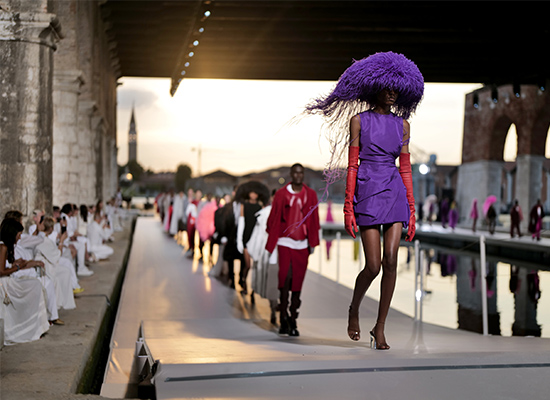The past couture season was a busy one. It was one of the most high-profile and buzziest weeks in a while, as it introduced multiple debuts and did so in person––the first from the previous two seasons. And as we see parts of the world slowly open up and regain “normalcy”, will things go back to the way they were?
Short answer: not really. The impact of the pandemic has brought a lot of issues to the fore, and led to confrontations and fundamental changes that will never see the industry go back to the way it used to be. Though shows are the grand extravaganzas that bring the industry (and now, the rest of the world) together each season in celebration of the latest designs, they were also notoriously known for being excessive and expensive to produce. In a digital, on-demand and eco-conscious age, were the expenses and pace of the traditional show schedule sustainable, or even relevant?

Many in the industry had already begun to examine the fashion system even before the pandemic hit. Editors complained of the overcrowded schedules and questioned the environmental impact of flying from city to city to attend one-off events whose sets would be immediately taken down afterwards. Once seen as a bible of sorts, the schedule became less defined as designers increasingly face the challenge of deciding when, where and whether to even show new designs due to economic and other constraints.
In 2016, Burberry was one of the first brands to change their model by deciding to only show two collections a year through coed shows that featured in-season designs available to be purchased immediately after. Designers like Philip Lim stepped away from the show system in favour of store events, presentations and dinners for more intimate, tailored experiences. Other brands like London-based designer Robert Wun have stuck to lookbooks or digital-only formats to present their collections.
View this post on Instagram
In a world that has become increasingly immediate, the traditional format of showing a collection four months before it was available to customers made zero sense. Especially not when shows were no longer just industry events but an opportunity to reach millions of people thanks to digital means.
Thus when the pandemic hit the world last year, many saw it as a clear sign that the system was broken. It sparked an industry-wide conversation on how it could become more mindful moving forward and put in motion subsequent shifts. In March, Giorgio Armani was one of the first designers to cancel his show, choosing to livestream it instead. Saint Laurent skipped Paris Fashion Week in September to reevaluate its fashion calendar, while Gucci followed suit by announcing it was going seasonless to abandon the “worn-out ritual of seasonalities” and scale back to show only twice a year.
View this post on Instagram
The world of haute couture also received a reckoning of relevancy. Purchased by the elite few of the world, the made-to-measure model was closely associated with social events, the red carpet, landmark parties––all of which were halted during the pandemic. Even so, it persisted through a digital-only format, with collections and presentations that expanded the world beyond. Designers like Valentino and Fendi introduced menswear offerings and the late, beloved designer of the fashion industry Alber Elbaz launched a RTW collection.
Fast forward to today, what did the recent shows say about the state of couture and the runway? With France loosening their lockdown restrictions in June, the recent season (and menswear shows) saw the immediate return of physical shows in combination with digital presentations. Though safety measures were put in place and masks were mostly in order, the in-person shows harked back to pre-Covid times (though it did remain through the screen for many). Majority of the shows were staged in enclosed spaces, with celebrities and fashion regulars spotted across the front row as models glided around the catwalk. Even so and unsurprisingly, they were done so with a consideration of intimacy and meaning that placed emphasis on the physicality and presence of the experience.
Demna Gvasalia para Balenciaga 2021 Couture pic.twitter.com/HAQXoEeU1D
— lola (@srawinter) July 12, 2021
Presented in complete silence, Balenciaga recalled the golden days of fashion’s most traditional core by transporting his guests back to the private salon days in a reconstructed atelier. His version of couture was not only reimagined for women and men but for an array of different bodies and genders that saw ready-to-wear pieces elevated with the house’s couture heritage. On the other hand, Dior’s presentation focused on high tactility to emphasise the craft of clothes, while Valentino staged a tear-jerker event that took place in a cultural environment with a live serenade and the sunset’s golden hour glow as part of its grand finale. Though fantastical, collections were more pared back with the introduction of staples, in response to the pandemic’s restructuring of wardrobes and notions of dressing, to signify a new direction of haute couture.
View this post on Instagram
Over in New York, Kerby Jean-Raymond of Pyer Moss made his debut as the first Black American designer on the couture schedule. Due to a freak rainstorm, the outdoor presentation at the historic Hudson River estate of Villa Lewaro was delayed two hours then rescheduled to two days after––a situation that could only take place IRL. Raymond subsequently changed his plans to make the show a public-facing event and offered a portion of the seats available to anyone who could get a hold of it. What transpired was a revolutionary moment that redefined what couture could mean through a celebration of Black innovations that was matched by a collective energy from the lively crowd of spectators who showed up to see it through.
| SHARE THE STORY | |
| Explore More |




